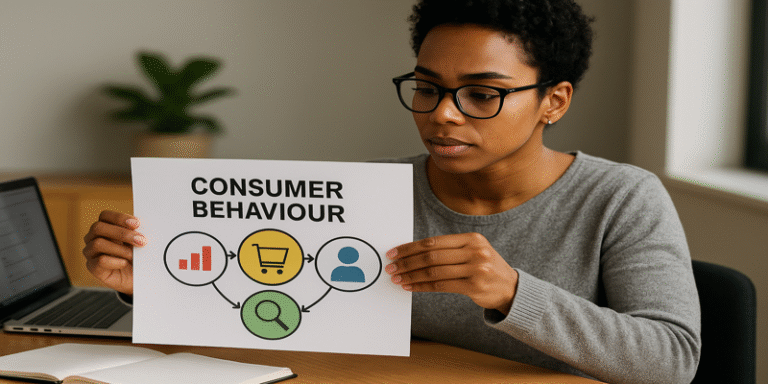Understanding consumer behaviour and psychology is vital for anticipating needs, tailoring services, and creating positive consumer experiences (Solomon, 2019). This comprehensive understanding involves delving into the intricacies of consumer behaviour, preferences, and decision-making processes, as well as considering cultural, psychological, and technological influences on consumption. In today’s competitive markets, businesses that effectively analyse consumer behaviour are better positioned to deliver value, foster loyalty, and achieve sustainable growth.
The Importance of Understanding Consumer Behaviour
In the realm of business, consumer behaviour analysis is fundamental for designing effective strategies. By identifying the factors that influence purchase decisions, organisations can create tailored offerings that resonate with consumer expectations. According to Solomon (2019), firms that understand the motivations behind consumer purchases are better able to meet needs, leading to enhanced satisfaction and loyalty. Similarly, Kotler and Keller (2016) argue that insights into consumer behaviour enable businesses to anticipate market trends and respond proactively, rather than reactively.
For instance, in the fashion industry, fast-fashion retailers such as Zara leverage consumer behaviour analysis to quickly adapt designs to emerging trends. By monitoring preferences and behaviours, Zara is able to shorten product development cycles, maintaining relevance and driving sales (Ghemawat & Nueno, 2006). This illustrates how understanding consumer behaviour can directly influence operational and strategic decisions.
Consumer Behaviour and Preferences
Consumer behaviour is defined as the study of how individuals allocate their resources to consumption-related activities, including what they buy, why they buy, when they buy, where they buy, and how they use and dispose of products. Schiffman and Wisenblit (2015) emphasise that consumer preferences are influenced by cultural, social, personal, and psychological factors.
- Cultural influences include values, traditions, and social norms that guide consumption. For example, dietary habits shaped by religion can strongly influence food purchases.
- Social influences involve family and peer groups, which often play a role in shaping brand choices and purchase decisions. Teenagers, for instance, may be influenced by peers when choosing clothing brands.
- Personal factors include age, lifestyle, and occupation, all of which affect product preferences. For example, young professionals may favour convenience-driven services such as meal delivery apps.
- Psychological factors such as motivation, perception, and learning guide how consumers interpret and respond to marketing stimuli.
Companies often use these insights to tailor their offerings. For example, Nike integrates social and cultural elements into campaigns, such as those promoting inclusivity and diversity, which resonate strongly with different consumer groups.
Psychological Influences on Consumer Behaviour
Psychological factors are among the most significant determinants of consumer behaviour. These include:
- Perception: The process by which consumers interpret sensory inputs to form a meaningful understanding (Kotler & Keller, 2016). For instance, packaging design and branding can influence perceptions of quality.
- Motivation: The internal drive that compels consumers to act, often explained by Maslow’s hierarchy of needs (1943). A luxury car may appeal to esteem needs, while organic food may address health and safety needs.
- Learning: Repeated experiences shape consumer responses. Loyalty programmes, such as those offered by airlines, reinforce repeat purchases through rewards.
- Beliefs and attitudes: These shape how consumers evaluate products and brands. Negative publicity can influence beliefs, reducing demand even if the product remains unchanged.
For example, the popularity of eco-friendly products reflects both motivational and attitudinal factors, as consumers increasingly value sustainability and ethical production.
Decision-Making Processes
The consumer decision-making process is typically described in five stages: need recognition, information search, evaluation of alternatives, purchase decision, and post-purchase behaviour (Engel, Kollat & Blackwell, 1968).
- At the need recognition stage, marketers create awareness of unmet needs through advertising.
- During the information search phase, firms can provide targeted digital content and customer reviews to influence choices.
- At the evaluation stage, comparisons between alternatives are made, with brand reputation often serving as a key determinant.
- The purchase decision reflects the outcome of these considerations, while
- post-purchase behaviour influences future loyalty and word-of-mouth recommendations.
For instance, in the smartphone industry, companies such as Samsung and Apple compete heavily in the evaluation stage by emphasising innovation and ecosystem benefits. Post-purchase satisfaction, reinforced by customer service, ensures ongoing loyalty.
The Role of Digital Behaviour Analysis
In the digital age, analysing online consumer behaviour has become increasingly important. Consumers leave digital footprints through browsing patterns, social media interactions, and e-commerce transactions. Chaffey and Smith (2017) argue that digital analytics tools allow businesses to capture these behaviours, generating valuable insights.
For example, online retailers track metrics such as click-through rates, dwell times, and cart abandonment to refine digital experiences. By using predictive analytics, companies can personalise content, improving engagement and conversion rates.
Netflix offers a powerful case study: its recommendation engine analyses user viewing patterns to suggest tailored content, keeping customers engaged and reducing churn (Gomez-Uribe & Hunt, 2016). This demonstrates how digital behaviour analysis translates into competitive advantage.
Case Studies and Applications
Several organisations have demonstrated the effectiveness of consumer behaviour analysis:
- Amazon employs advanced algorithms to analyse shopping patterns and recommend products (Smith, 2018). This personalised experience significantly boosts sales and customer retention.
- Starbucks uses loyalty card data and mobile app insights to refine product offerings. Garthwaite (2017) notes that by aligning menu innovations with customer preferences, Starbucks enhances both satisfaction and loyalty.
- Coca-Cola conducts extensive consumer research to adapt to cultural preferences in global markets. Its strategy of offering locally customised flavours demonstrates how behavioural insights can support global expansion (Pendergrast, 2013).
These cases illustrate that understanding consumer behaviour is not only an academic pursuit but also a practical necessity for achieving market success.
Challenges in Understanding Consumer Behaviour
While consumer behaviour analysis offers immense value, it is not without challenges.
- Complexity of behaviour: Human decision-making is influenced by numerous interrelated factors, making behaviour difficult to predict accurately (Schiffman & Wisenblit, 2015).
- Rapid change: Consumer preferences shift rapidly, influenced by technological advances and cultural trends. For example, the rise of plant-based diets reflects evolving health and sustainability concerns.
- Privacy concerns: Digital behaviour analysis raises ethical issues regarding data collection and usage. Striking a balance between personalisation and privacy is critical in building trust (Solomon, 2019).
These challenges highlight the importance of combining traditional research with modern analytics, while maintaining ethical standards.
In conclusion, understanding consumer behaviour and psychology is critical for businesses aiming to thrive in competitive markets. By analysing behaviour, preferences, and decision-making processes, companies can anticipate needs, create tailored strategies, and deliver superior experiences. Psychological factors such as motivation, perception, and attitudes shape consumption, while frameworks like the five-stage decision-making process guide strategic interventions.
The digital era has added new layers of complexity, with behavioural analytics offering powerful tools for gaining insights. Organisations such as Amazon, Starbucks, and Netflix exemplify how consumer behaviour analysis can be harnessed to achieve growth and loyalty.
Ultimately, successful organisations will be those that not only understand consumer behaviour but also adapt continuously, integrating traditional theories with modern digital insights while upholding ethical standards. This dynamic approach ensures that businesses remain customer-focused, innovative, and resilient in an ever-changing marketplace.
References
Chaffey, D. & Smith, P.R., 2017. Digital Marketing Excellence: Planning, Optimizing and Integrating Online Marketing. 5th ed. London: Routledge.
Engel, J.F., Kollat, D.T. & Blackwell, R.D., 1968. Consumer Behavior. New York: Holt, Rinehart, and Winston.
Garthwaite, C., 2017. The Starbucks Experience. Harvard Business Review. Available at: https://hbr.org/2017/09/the-starbucks-experience [Accessed 28 July 2024].
Ghemawat, P. & Nueno, J.L., 2006. Zara: Fast fashion. Harvard Business School Case Study, 9-703-497.
Gomez-Uribe, C.A. & Hunt, N., 2016. The Netflix recommender system: Algorithms, business value, and innovation. ACM Transactions on Management Information Systems, 6(4), pp.1–19.
Kotler, P. & Keller, K.L., 2016. Marketing Management. 15th ed. Harlow: Pearson.
Maslow, A.H., 1943. A Theory of Human Motivation. Psychological Review, 50(4), pp.370–396.
Pendergrast, M., 2013. For God, Country, and Coca-Cola. 3rd ed. New York: Basic Books.
Schiffman, L.G. & Wisenblit, J., 2015. Consumer Behavior. 11th ed. Harlow: Pearson.
Smith, A., 2018. Amazon’s Recommendation System. Journal of Digital Commerce, 12(3), pp.45–56.
Solomon, M.R., 2019. Consumer Behavior: Buying, Having, and Being. 13th ed. Harlow: Pearson.









